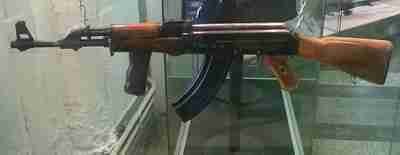Yet again the Naxal-Maoists’ move in the Northeast has been acknowledged by the Union Home Minister, P Chidambaram and Chief Minister of Assam, Tarun Gogoi. Addressing the Chief Ministers’ conference on internal security on April 16, Chidambaram said, “Assam had emerged as the new theatre of Maoist activity and there were also inputs about links of CPI (Maoist) with insurgent-turned-terrorist groups in Manipur and Arunachal Pradesh.”
On May 12, while on a tour of Arunachal Pradesh, Chidambaram is reported to have said that there would be no compromise with Maoists trying to destabilise peace in the Northeast. At a press conference in Itanagar, he said, “The centre was alive to the situation created by such groups in the region and was taking concrete steps to curb them and said state governments of the region had been asked to deal with the ultras with a firm hand.There will be no compromise in dealing with the Maoists trying to destabilise peace in the region and police has been instructed to take stern action.”
Stating that there was “Minimal presence” of Maoists in the region, he expressed appreciation of the steps taken by Assam and Arunachal Pradesh governments to deal with them. “There is no reason to allow such elements (Maoists) to settle in the region and create disturbances,” he said and appealed to the people not to encourage the Maoists.
Accompanied by Union Minister of State for Home Jitendra Singh, he held a high-level meeting to review the security situation in the State.
While on the one hand, he expressed satisfaction with the security system of the state, on the other he stressed: “Efforts will continue as per plan.” On April 8, the National Investigating Agency (NIA) scored a success in snapping a major link between the Maoist rebel groups and Manipur based militant group Peoples Liberation Army (PLA) by arresting a hardcore cadre Arnold Singh alias Bekon, working at a call centre in Siliguri. According to official sources Arnold, who originally hails from Guwahati, joined the PLA in 2003 and following the signing of an agreement between the Maoist rebels and PLA, he led a four-member team of the PLA to Jharkhand where they imparted training to several batches of Maoist rebels.
Assam and unrest
One of the indicators of this incident is the outreach or spread of Northeast terrorist groups within the region well away from their respective states. While PLA, of Manipur, has had major links with Pakistan’s Inter-Services Intelligence (ISI) in Bangladesh and also a presence there from the period of Bangladesh Nationalist Party’s it also has bases in a number of Northeastern states too. On May 9, Assam police claimed to have killed four unidentified Maoists activists in an encounter in Tinsukia district.

Police recovered two AK-47 and one AK-56 rifle, 3 live grenades, 53 rounds of live ammunition, a detonator and several extortion demand notes from them. While this operation by Assam police was successful, it exposes only a tip of the iceberg. Because it is not only the advent of Maoists making inroads into Assam as the late leader Kishenji’s visit there proved, the fact that there are ethnic Assamese being identified as Maoists means that the process of recruiting Assamese into their organisation has progressed.
Gogoi is reported to have directed top state officials to immediately prepare an action plan for setting up a taskforce to contain increasing Maoist activities in the state and announced that Assam police taskforce/core group would be formed under an additional director general of police to contain Maoist activities and counterfeit currency racket in the state.
“Maoist activities” in Assam will no doubt be supported by the so-called anti-talks United Liberation Front of Asom (ULFA) and if not nipped in the bud will spread to other states of the Northeast with support from ULFA’s other crony groups comprising Bodos, Nagas, and Meiteis. National Socialist Council of Nagaland/Nagalim-Isaac-Muivah (NSCN-IM) and PLA. Further, already there has been a major development of yet another attempt at bringing together fourteen terrorist groups of the Northeast together.
So Gogoi’s formula of raising yet another police or special force or re-organising the existing one will be easier said than done because neutralising a combo of pan Northeast groups and Naxal-Maoists together that too with Chinese support over and above substantial long-standing support of ISI, will require a complete makeover of state and central police, if the Army is to be kept out of the ambit.
Finding the answers
This will involve substantially increasing the numbers of the force, providing it good training at institutes like Counter Insurgency and Jungle Warfare School at Vairengte, Mizoram, providing better weapons, communications and mobility and most important, dynamic leadership. Even if all this is achieved, the political will to disregard political connections and vote-bank interests will be needed to strike at the roots of these terrorist groups.
In February, this year, Rajeev Bhattacharyya, working for a Northeast media publication spent a few days in an ULFA camp set up ideally in Eastern Nagaland with advantages like it being contiguous to Nagaland and Manipur, proximity to Myanmar, only a few days walk from Upper Assam and well connected by rivers and jungle pathways, making the delivery of weapons and supplies easy. In that camp he witnessed a huge consignment of European 9mm pistols and HK33 assault rifles being delivered. Though Heckler and Koch do not make the HK33 anymore, variants of the rifle were produced under licence in some south Asian countries.
Once the consignment was unpacked, cadres test-fired the guns before putting them into storage. Sources were cited that orders were being placed for the Chinese Type 81 rifles and the American M16 — both in the price range of `2,00,000 — to `3,00,000. Interestingly, “Concessional rates” apply for orders are placed in bulk, and the united front benefits from slashed rates. Medicines, food and goods not available in Myanmar are smuggled in from China and Thailand.
The other very exciting but ominously significant event he witnessed was a soccer match, in which Paresh Baruah’s blue team comprising cadres from ULFA, the National Democratic Front of Bodoland (NDFB) and the Nationalist Socialist Council of Nagaland-Khaplang (NSCNK) played against the blue team made up of Manipuri terrorist groups, which won, 4-2.
To pack a “lethal punch” to their demand for the sovereignty of the region, as many as 14 terrorist outfits signed an agreement last year to form yet another joint forum which they claim is already in place, but not yet been given a new name and will be different from similar efforts in the past. Also, a new outfit in Arunachal Pradesh has been recently formed with the same objectives. ULFA, NSCN-K and PLA of Manipur have played a crucial role in forming this group.
The outfits will coordinate their activities and share information on sources of weapons. Another disturbing development is Baruah’s open show of solidarity to China by condemning counter-China moves from the soil of ‘Asom’, the word which he wants all members of his outfit to suffix to their names. In an email statement sent to an Assam portal claiming “Good diplomatic ties” with the People’s Republic of China and that there is no point to burning the Chinese flag in the soil of Assam (with reference to the 1962 Chinese aggression.
He is crying out hoarsely about Indian government secretly setting up nuclear Missile Bases in Northeast India, especially in Assam. Baruah claimed that surveys had been completed for setting up bases for Brahmos cruise missile in Nagaland and nuclear missile Akash in Assam as well as Indian Air Force taking over huge areas of land in the state to set up Airbases in the state. He warned that if China targeted Indian missile bases in Assam, it would be “Completely destroyed” and that Assam should build bridges with China for its own safety as India is treating Assam ruthlessly.
There is no dearth of affinity between many militant groups within India. Naxal-Maoists have received arms, ammunition, explosives and other equipment as well as training by the north-eastern groups. At least by late 2009, it got to be known that consignments, of weapons by arrangement with China amounted to 850 AK-47 rifles, 4,000 small weapons and several hundred grenades, were supplied to the Naxals through Burma and Bangladesh by an elaborate network run in the Northeast by the NSCN(I-M).
With Bangladesh-based ULFA leaders having extended their connections to China, the supply of arms from Yunan province of southern China through insurgents in Burma became another new route.


